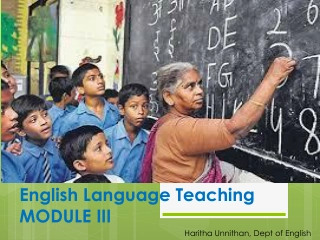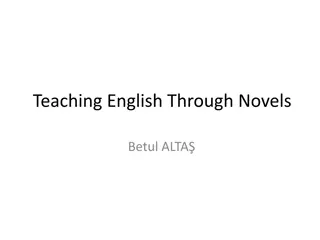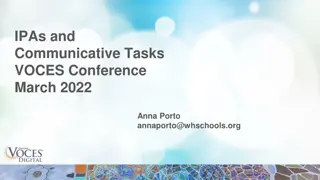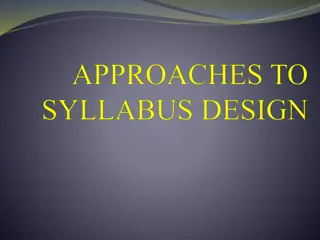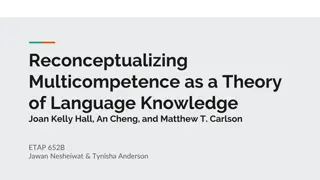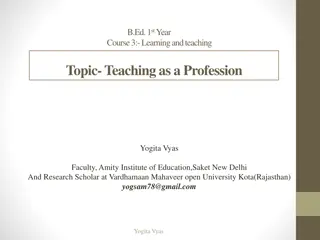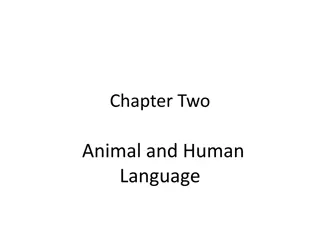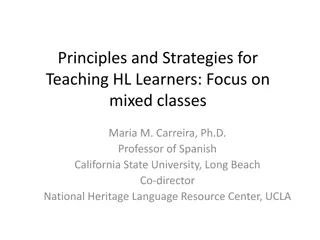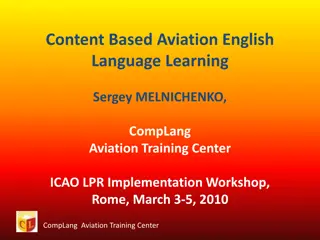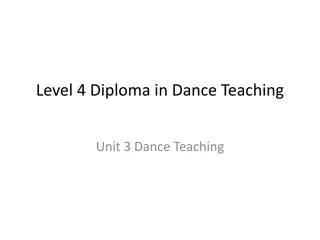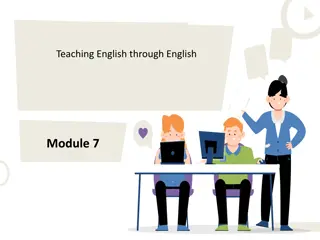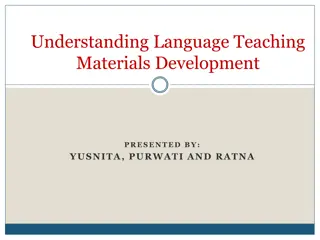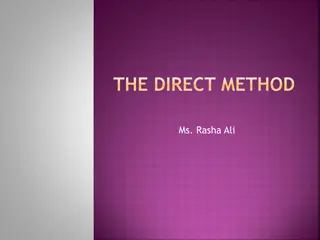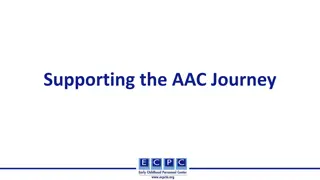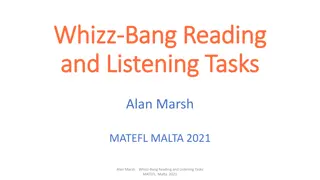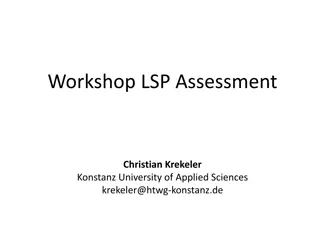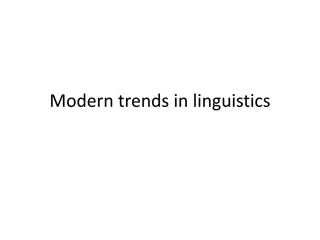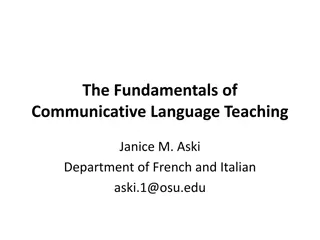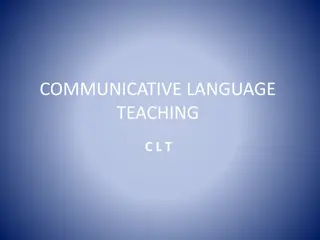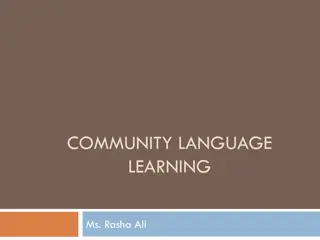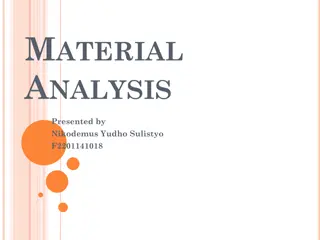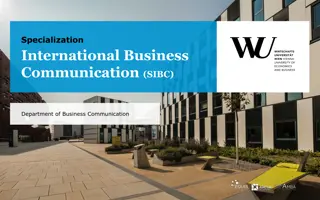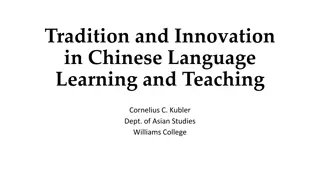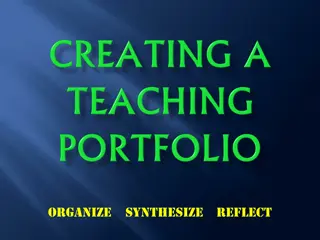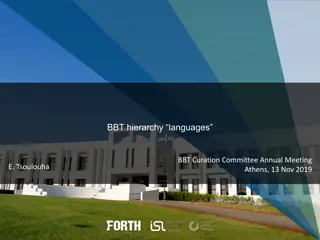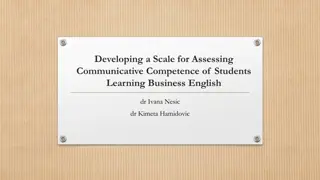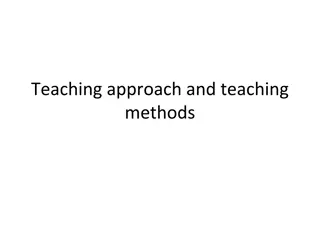English Language Teaching MODULE III
The different methods of language teaching, including Grammar Translation, Direct, Audio-Lingual, Audio-Visual, and Communicative approaches. Learn about their characteristics, advantages, and disadvantages.
3 views • 33 slides
Community Language Learning
Community Language Learning (CLL) involves collaborative language learning where teachers act as counselors and learners work together. CLL teachers aim to teach communicative language skills, foster self-learning, and mutual learning among students through valuing thoughts and feelings. Popular
2 views • 14 slides
Teaching Observation Process and Best Practices
Explore the teaching observation process with a focus on fostering faculty success and improving teaching practices. Learn about pre-observation meetings, separating observation from evaluation, and utilizing observations to spark dialogue about effective teaching. Access resources such as the Teach
7 views • 20 slides
Exploring the Role of Novels in Teaching English Proficiency
Utilizing novels in English language teaching offers authentic and engaging cultural material, enhancing linguistic and communicative skills development. The shift towards cognitive methodologies has highlighted the significance of literature in creating meaningful learning contexts. Despite challen
1 views • 40 slides
Enhancing Language Proficiency Through IPAs and Communicative Tasks
Explore the integration of Integrated Performance Assessments (IPAs) and Communicative Tasks in language teaching, focusing on building student proficiency in reading, listening, speaking, and writing. Discover practical tips for implementing and managing IPAs, along with engaging communicative task
1 views • 16 slides
Understanding Language Teaching Syllabus: Integration, Theory, and Approaches
Language Teaching Syllabus involves the integration of subject matter and linguistic elements, guided by theories of language and learning. Various approaches like Grammatical, Situational, Communicative, and Analytic are used to structure syllabi. Breaking language into parts aids in sequential lea
1 views • 28 slides
Understanding Multicompetence Theory in Language Knowledge
Multicompetence theory, as proposed by Vivian Cook, describes a unique state of language knowledge where bilinguals exhibit enhanced cognitive abilities compared to monolinguals. Evidence shows bilinguals excel in tasks requiring linguistic analysis, divergent thinking, metalinguistic awareness, and
2 views • 13 slides
Importance of Teaching English at Different Education Levels
English language holds a significant position in the educational system and national life of India. This presentation by Dr. A. Mary Delphine highlights the aims and objectives of teaching English, emphasizing its importance in India and the modern world. The objectives include understanding the rat
1 views • 32 slides
Co-Teaching in Student Teaching: A Collaborative Approach
Co-teaching in student teaching involves mentor teachers and student teachers working together to plan, deliver, and assess instruction while sharing responsibilities and opportunities for collaborative pedagogy. It is a model that enhances student learning by engaging two teachers actively in the c
0 views • 21 slides
Understanding Teaching as a Profession by Yogita Vyas
Explore the comprehensive module by Yogita Vyas focusing on the nature of teaching, characteristics of effective teaching, importance of teaching as a profession, and qualities of a professional teacher. Gain insights into the teaching profession, its role in society, and the essential skills requir
1 views • 27 slides
Uniqueness of Human Language and Communication Contrasted with Animal Communication
Human language possesses unique properties such as reflexivity, displacement, and arbitrariness, setting it apart from animal communication. These distinctions enable humans to communicate abstract concepts, discuss past and future events, and use arbitrary linguistic forms. The contrast between hum
1 views • 17 slides
Teaching Strategies for Heritage Language Learners in Mixed Classes
Explore essential concepts in teaching heritage language learners in mixed classes, focusing on project-based teaching. Understand the characteristics of native speakers, heritage speakers, and second language learners. Learn about the motivations of heritage language learners and the implications f
1 views • 48 slides
Content-Based Aviation English Language Learning Overview
Explore the significance of content-based learning in aviation English language training. Delve into scenarios such as the Avro 685 Crash Landing, Midair Collisions, and communication challenges faced in radio telephony exchanges. Understand the importance of well-formed communicative competence and
1 views • 19 slides
Level 4 Diploma in Dance Teaching Unit 3 Overview
In Level 4 Diploma in Dance Teaching Unit 3, the focus is on dance teaching practice. The learner is observed teaching a class, supported by written evidence such as teaching logs and lesson planning. Continuous Professional Development activities are also emphasized. The examination involves teachi
0 views • 8 slides
Developing Communicative Competence in English Language Teaching
In English language teaching, the main goal of a communicative classroom is to foster students' communicative competence. This includes grammatical competency, sociocultural competency, discourse competency, and strategic competency. By focusing on these aspects, educators aim to enhance students' a
0 views • 7 slides
Teaching Staff Digital Experience Insights Survey Results 2020-21
This presentation provides insights from the Teaching Staff Digital Experience Insights Survey for the year 2020-21. It focuses on key metrics related to technology at the organization, technology in teaching, and the development of digital skills among teaching staff. The survey collected feedback
2 views • 26 slides
Teaching English: Adapting Materials for Effective Communication
Explore ways to analyze and adapt textbook lessons for meaningful use in English language teaching. Learn how to enhance classroom interactions by utilizing various teaching resources to develop engaging communicative activities suited for diverse learning environments.
0 views • 10 slides
Exploring Language Teaching Materials Development
Language teaching materials play a crucial role in language learning processes. They can be informative, instructional, experiential, eliciting, or exploratory. Materials development involves various processes such as evaluation, adaptation, design, production, exploitation, and research. Frameworks
0 views • 30 slides
The Direct Method in Language Teaching
The Direct Method, also known as the DM, emphasizes teaching the target language without translation. It aims to improve students' communication skills and focus on vocabulary and pronunciation over grammar. Teachers play a direct role in class activities, while students engage in interactive langua
0 views • 8 slides
Supporting the AAC Journey: A Specialist's Perspective
Although conventional communication may not be present, recognizing different signals is crucial in shaping functional communicative behaviors. Specialists play a vital role in enhancing language potential through AAC, impacting future language development. Using aided language modeling and fosterin
0 views • 7 slides
Effective Reading and Listening Strategies in Language Teaching
Explore the various purposes and tasks involved in communicative language teaching, focusing on reading and listening skills development. Understand the importance of activating schemata, developing reading strategies, and language production activities such as speaking and writing. Delve into diffe
0 views • 39 slides
Revisiting PESP Genre: Problems, Issues, and Solutions
This discussion revisits the problems and issues associated with communicative purpose and social purpose in ESP/Swalesian genre analysis. It delves into the definition and differentiation of communicative purpose (CP) and social purpose (SP), offering insights into their roles in text classificatio
0 views • 20 slides
Understanding Simulated Teaching for Effective Classroom Training
Simulated teaching is a powerful training technique that uses role-playing to change student behavior. It helps student teachers practice teaching skills in artificial scenarios before real classroom situations. This method allows for effective feedback, easy implementation, and the opportunity to r
0 views • 11 slides
Task-Based Language Assessment: Adapting LSP Tasks for Assessment Purposes
Explore the integration of Task-Based Language Assessment (TBLA) with Language for Specific Purposes (LSP) tasks to enhance assessment purposes in educational settings. Discover the complexity, authenticity, and cognitive demands of adapting tasks, aiming for communicative outcomes in a real-world c
0 views • 24 slides
Understanding Communicative Acts on Social Networking Sites
Exploring the taxonomy of communicative acts on social networking sites, this work delves into the impact of design features that influence speech acts, commitment, and normative pressures online. By analyzing common families of communicative acts on SNSs, the research sheds light on how these platf
0 views • 29 slides
Understanding Language Anxiety in Foreign Language Learning and Teaching
Explore the impact of language anxiety on students and teachers in foreign language learning and teaching contexts through insights from Dr. Christina Gkonou's research. Delve into the theoretical background, implications for language education, and real-life experiences shared at the Essex Language
0 views • 25 slides
Understanding Natural Language Generation (NLG) Process
Natural Language Generation (NLG) is the process of constructing natural language outputs from non-linguistic inputs. It involves generating text from machine representations to meet specific communicative goals. NLG is distinct from Natural Language Understanding (NLU) as it maps meaning to text, w
0 views • 38 slides
Exploring Modern Trends in Linguistics
Cognitive linguistics, functional grammar, text linguistics, and communicative linguistics are shaping the field of linguistics in the 21st century. These trends delve into the cognitive aspects of language, emphasizing language's role in organizing and conveying information. Cognitive linguistics h
0 views • 37 slides
USC Teaching Excellence Initiative Progress Report
The USC Teaching Excellence Initiative highlights progress in developing a School Teaching Plan with five key elements, focusing on faculty-led processes, defining teaching excellence, supporting faculty development, evaluating teaching excellence, and rewarding outstanding performance. The Center f
0 views • 6 slides
Exploring Communicative Language Teaching Fundamentals
Communicative Language Teaching focuses on real-life situations to facilitate meaningful communication. This approach aims to teach language through practical interactions, with a particular lesson goal being to learn how to greet, introduce oneself, and ask about others' names and origins. It empha
0 views • 23 slides
Principles of Communicative Language Teaching (CLT)
Communicative Language Teaching (CLT) emphasizes the importance of enabling students to communicate in the target language effectively in real-life situations. This approach focuses on developing linguistic competence and communicative competence to ensure learners can use the language proficiently.
0 views • 15 slides
Effective Community Language Learning Method by Ms. Rasha Ali
Community Language Learning (CLL) method emphasizes understanding students' feelings and creating a supportive environment for language learning. This approach, influenced by the Counseling-Learning approach, focuses on building relationships, reducing anxiety, and promoting effective communication
1 views • 15 slides
Understanding the Analysis of Language Teaching Materials
This material analysis presentation by Nikodemus Yudho Sulistyo delves into the aspects to examine, methodologies for materials analysis, and connecting findings to teaching contexts. It covers the pedagogic devices, design aspects, and levels of analysis for language teaching materials, emphasizing
0 views • 26 slides
Specialization in International Business Communication (SIBC)
Specialization in International Business Communication (SIBC) offered by the Department of Business Communication focuses on the critical role of communication in various business settings, emphasizing skills in language usage, communicative competence, and strategic language application. The progra
0 views • 11 slides
Tradition and Innovation in Chinese Language Learning
Continuous innovation is crucial in Chinese language teaching while preserving the value of traditional methods. Strategies like memorization help students internalize language effectively, leading to improved communicative competence. Utilizing model conversations and drills can enhance vocabulary,
0 views • 29 slides
Enhancing Your Teaching Portfolio with Effective Strategies
Empower your teaching portfolio by organizing, synthesizing, and reflecting on essential elements like syllabi, exams, and teaching philosophy. Write a captivating introduction, update your curriculum vitae, and craft a personal statement to highlight your qualifications and career goals. Share your
0 views • 10 slides
Exploration of Language Hierarchies in BBT Curation Committee Annual Meeting
Delve into the categorization of languages within the BBT hierarchy, discussing the distinctions between natural and formal languages, potential restructurings of language classification, and considerations for expressing communicative power through different language forms.
0 views • 12 slides
The Study of Language: Understanding Communication in Humans and Animals
Language is described as an arbitrary system of vocal symbols used for communication. Animals communicate through various methods, such as sounds, visual cues, and scents. Human language involves duality, allowing for the combination of sounds to convey meaning. Animals lack the ability to break dow
0 views • 11 slides
Understanding Communicative Competence in Business English Students
Developing a scale for assessing communicative competence in students learning Business English involves understanding the models of communicative competence, the difference between communication and communicative competence, as well as the relationship between language knowledge and language use. T
0 views • 29 slides
Effective Teaching Approaches and Methods for Educators
Characteristics of good teaching include being sensitive to students' abilities and needs, using effective teaching methods, and integrating interactive teaching approaches. Teachers should structure their teaching in relation to students, be familiar with the curriculum, and develop methods that en
0 views • 40 slides
